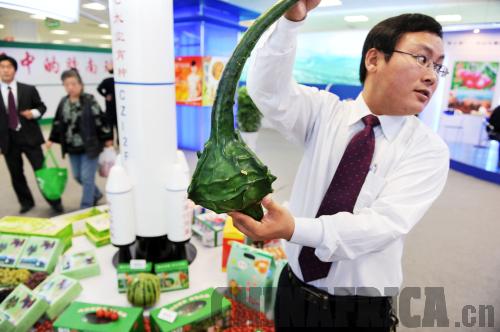| 
This past June, the spacecraft Shenzhou-9 made international headlines because its crew included the first Chinese woman astronaut to reach space. But the mission was not just about who was on board. Joining the astronauts in orbit was a series of innocuous looking bags. Inside the bags were seeds, primed to mutate and representing the final frontier of another major Chinese accomplishment: space breeding.
Space breeding, despite the out-of-this-world name, is pretty down to earth. Unlike genetically modified organisms (GMO), which involve transferring foreign genes into a crop, space breeding does not tamper with a seed's genome in a lab setting. "It is just a new kind of methodology to induce gene mutation naturally," says Professor Liu Luxiang, of the technology, which has been around since the late 1980s. Liu is the director of China's National Space Breeding Research Center located in Beijing.
In outer space, seeds are exposed to a unique combination of cosmic radiation and microgravity – an environment and state of weightlessness completely unlike the conditions in which plant life evolved over the course of billions of years on Earth. The results from exposure are startling, with many seeds producing all kinds of behemoths, from 21-lb tomatoes to two-foot long cucumbers to gargantuan pumpkins. There are many who believe the technology could be the answer to food shortages around the globe. But for Liu, this possibility is a long way off.
"Currently the program is just in a research phase," he says. "It's just for scientists, not regular people." Too many unknowns need to be answered, he says, before that can happen.
"The optimal time in space?" Liu laughs. "It's a very difficult question." Repeat experiments, he says, are virtually impossible. "In the past, we could launch 23 or 24 recoverable satellites and other spacecraft. But different satellites spend different amounts of days in space, and I think the cosmic rays in space change every time, so we cannot compare the effects [against each other]."
Cost is also a major obstacle. "The space program is a very limited opportunity and the cost is expensive for us," explains Liu. "We need to pay a boarding fee for the seeds on the satellite, and the fees are different. Sometimes you see a fee for 1 gram of seeds that is 500 Chinese yuan ($80.6) and sometimes it's several thousand yuan. This is why we try to use our facilities to simulate some factors in space."
At his research center in Beijing, Liu and his colleagues have set up an accelerator that produces high-energy ion beams to study the bio-effect of ion particles on seeds. Also on site is an installation that simulates the weak or magnetic-free conditions found in space, and other experiments that mimic the effects of microgravity. "This is cheaper than [sending seeds to] space, but it's just a single factor tested in each simulation," says Liu, who believes it's the complex mix of factors in orbit that makes space breeding an indispensible technology.
"In the past five to six years, we have had very active international cooperation activities with space breeding," says Liu. With support from the International Atomic Energy Agency (IAEA), Liu and his team are able to make their simulation facilities available to other IAEA member states. They are also able to distribute space-bred seeds – "mutant lines" as they're called – to other IAEA members.
"I visit Kenya regularly because we have an international project for wheat improvement against stem rust resistance and have provided some mutants for testing at Moi University," notes Liu.
Professor Miriam Kinyua, who oversees the testing of these lines at the university in Eldoret, is also affiliated with the IAEA. "We are able to achieve a desired change of traits in a shorter amount of time than with conventional breeding, [and] the change is accepted by consumers better than with GMO," she says of the appeal behind space breeding.
Kinyua is eager to see Kenyan seeds sent into space on a future Chinese mission. For her, as a plant breeder, the research possibilities are endless. Though she acknowledges the costs are prohibitive, she advises African scientists look for alternative ways to get involved in space breeding. "Test available new technologies when the opportunity avails itself," she says.
Liu, for one, is open to helping. "I'm looking forward in the future to having more international cooperation in this field." |